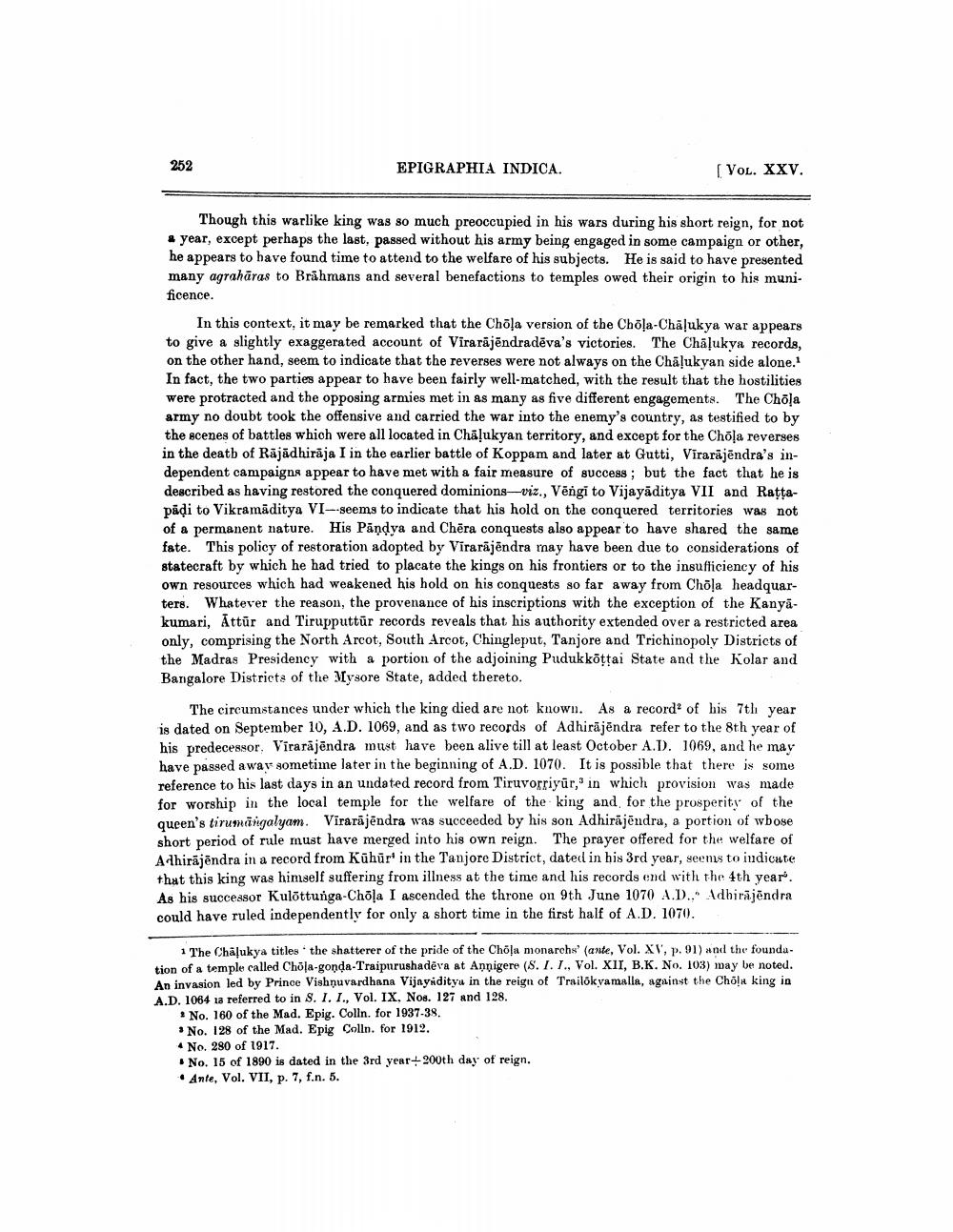________________
252
EPIGRAPHIA INDICA.
(VOL. XXV.
Though this warlike king was so much preoccupied in his wars during his short reign, for not . year, except perhaps the last, passed without his army being engaged in some campaign or other, he appears to have found time to attend to the welfare of his subjects. He is said to have presented many agrahāras to Brāhmans and several benefactions to temples owed their origin to his munificence.
In this context, it may be remarked that the Chola version of the Chõļa-Chāļukya war appears to give a slightly exaggerated account of Virarājēndradēva's victories. The Châļukya records, on the other hand, seem to indicate that the reverses were not always on the Chāļukyan side alone. In fact, the two parties appear to have been fairly well-matched, with the result that the hostilities were protracted and the opposing armies met in as many as five different engagements. The Chola army no doubt took the offensive and carried the war into the enemy's country, as testified to by the scenes of battles which were all located in Chāļukyan territory, and except for the Chõļa reverses in the deatb of Rajadhiraja I in the earlier battle of Koppam and later at Gutti, Virarājēndra's independent campaigns appear to have met with a fair measure of success; but the fact that he is described as having restored the conquered dominions-viz., Vēngi to Vijayaditya VII and Rattapādi to Vikramaditya VI---seems to indicate that his hold on the conquered territories was not of a permanent nature. His Pandya and Chēra conquests also appear to have shared the same fate. This policy of restoration adopted by Virarājēndra may have been due to considerations of statecraft by which he had tried to placate the kings on his frontiers or to the insufficiency of his own resources which had weakened his hold on his conquests so far away from Chola headquarters. Whatever the reason, the provenance of his inscriptions with the exception of the Kanyakumari, Artūr and Tirupputtūr records reveals that his authority extended over a restricted area only, comprising the North Arcot, South Arcot, Chingleput, Tanjore and Trichinopoly Districts of the Madras Presidency with a portion of the adjoining Pudukkottai State and the Kolar and Bangalore Districts of the Mysore State, added thereto.
The circumstances under which the king died are not known. As a record of his 7tlı year is dated on September 10, A.D. 1069, and as two records of Adhirājēndra refer to the 8th year of his predecessor, Virarājēndra must have been alive till at least October A.D. 1069, and he may have passed away sometime later in the beginning of A.D. 1070. It is possible that there is some reference to his last days in an undated record from Tiruvorriyūr, in which provision was made for worship in the local temple for the welfare of the king and for the prosperity of the queen's tirumangalyam. Virarājēndra was succeeded by his son Adhirajëndra, a portion of wbose short period of rule must have merged into his own reign. The prayer offered for the welfare of A thirājēndra in a record from Kūhūrs in the Tanjore District, dated in his 3rd year, seems to indicate that this king was himself suffering from illness at the time and his records end with the 4th year. As his successor Kulottunga-Chola I ascended the throne on 9th June 1070 A.D..Adbirājēndra could have ruled independently for only a short time in the first half of A.D. 1070.
1 The Chalukya titles. the shatterer of the pride of the Chola monarchs' (ante, Vol. XV, P.01) and the foundation of a temple called Chola-gonda-Traipurushadēva at Annigere (S.I.T., Vol. XII, B.K. No. 103) may be noted. An invasion led by Prince Vishnuvardhana Vijnyiditya in the reign of Trailokyamalla, against the Cho! king in A.D. 1064 na referred to in 8. I.I., Vol. IX. Nos. 127 and 128.
* No. 160 of the Mad. Epig. Colin. for 1937-38. * No. 128 of the Mad. Epig Colln. for 1912. • No. 280 of 1917.
No. 15 of 1890 is dated in the 3rd year+ 200th day of reign. • Ante, Vol. VII, p. 7, f.n. 5.




